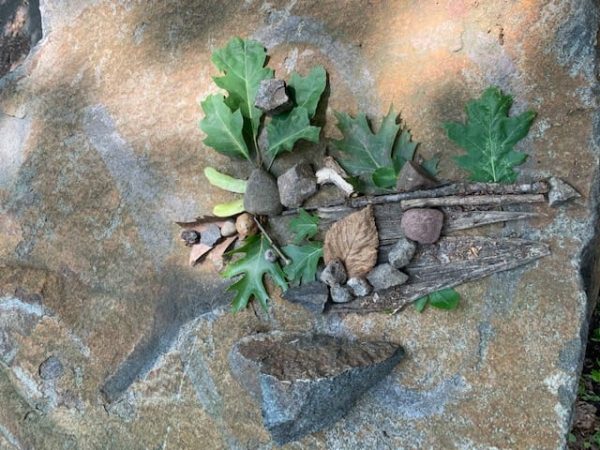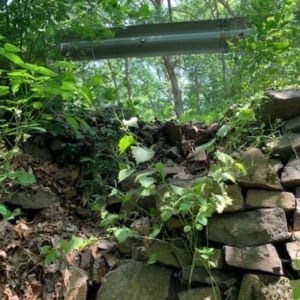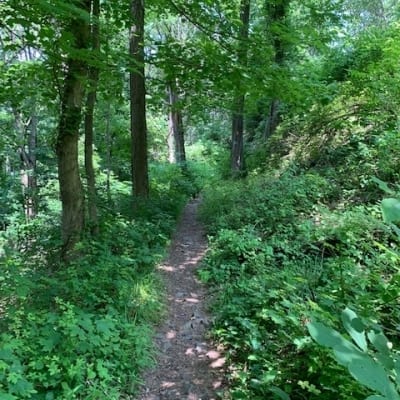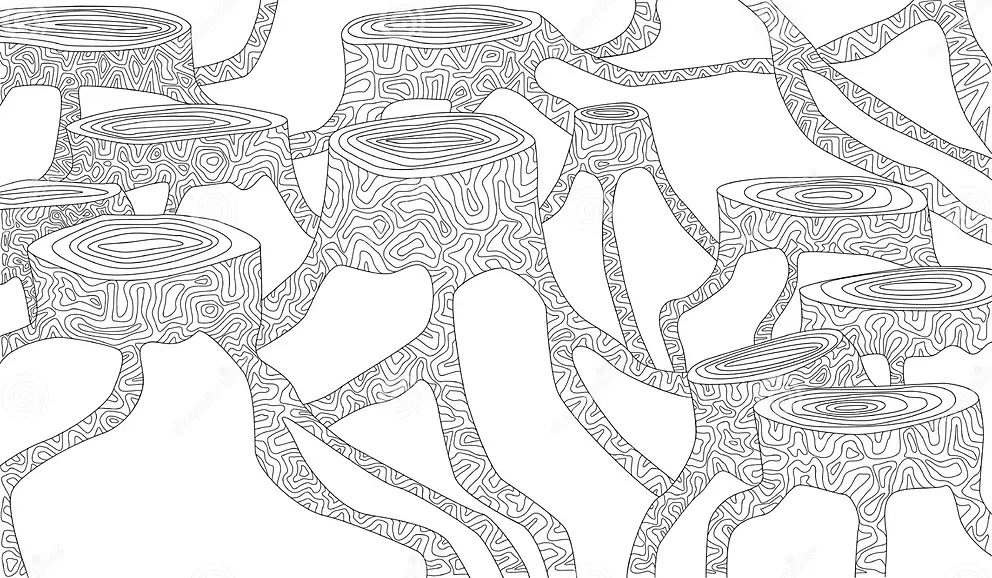Story Info
Story Info

Liz Hanna
East Rock Park
2019
Type of Wounded Place
Story & Experience
The walk through the park to the site I had in mind was a mixed experience for me: I walked with my partner, who is not familiar with the paths, and felt somewhat self-conscious of the activity we were heading into: a public display of love, in a sense; of investment, feeling, joy, gratitude. I had imagined the day in advance but didn’t anticipate how nervous I would feel when it actually came time to create this offering. I was given gifts along the way—reminders of where I’ve been in relationship with the land and with my own awareness & understanding of that relationship; reminders of vulnerability and courage.
As we approached the final section of trail before the steep upward section to the paved road, I marveled at how lush and green the foliage had become—we had had so much rain lately—and it took me a moment to find the garbage bags, hidden in the leaves, down the long slope to our left. To our right was a depression in the soil below the guard rail, strewn with litter and debris from heavy objects sliding past. I felt the familiar anger and sadness, and frustration that such a stupid, small mindlessness could continue to play out in the world while the huge things, the larger-scale atrocities that are harder for us to influence, rage on daily. Can’t we at least agree not to trash our own parks? Apparently not fully. I passed through the frustration to a desire to attend to the place itself. The day was warm and sunny, and more birds that I could name sent their voices out and about on the breeze.
We arrived at the turn-out off the road, with the reservoir off to our left and the road to the right, and the steep side of the hill climbing up beyond it. I wasn’t sure whether anyone else would come, and it did end up just being my partner and I—which had the effect for me, I think, of letting me attend more fully to my own relational experience of being there. Mark and I gathered a variety of leaves, pebbles, acorns, and debris and brought them over to a promising large stone by the edge of the road. We began to arrange them together on its approximately flat top, weighing the pieces down with small rocks to keep them from blowing away in the stiff breeze. At one point I stopped what I was doing to watch, in what I hoped was an obvious fashion, as a pickup truck with a bed full of something pulled over nearby and idled. I felt like I was guarding this place with my presence (which I have often fantasized about doing—if I could stay there all the time, could I protect this spot?). In my mind I felt suspicious of this person, and the juxtaposition of my suspicion with the intention to bring beauty and to honor this place was not an easy one to sit with.
When the man eventually left, we resumed our creation. For various reasons, sharing my love of a place in an explicit way with other people has not been an easy thing—I have learned to expect (and fear, earlier in life) ridicule and trivialization when trying to share the experience of relationship—of love, the kind that tells you who you are—with the natural world. It’s only in recent years that I’ve come to have some tools and language to live into this in a more visible way, and sharing this experience with my partner was a special opportunity to do that without having to take on the worry or anxiety of being mocked or misunderstood. We didn’t say much—though when we deemed that the design was complete, I offered words of thanks and appreciation to the place itself. I gave thanks for its enduring self, its mystery and generosity, and all it had taught me. We left the design in place and walked home the way we had come.
I had to remind myself many times throughout this experience that I was not there to solve the problems I saw affecting that hillside; that this expression of radical joy is not a replacement for the other steps we take to try to make things better, nor even just a way of augmenting or reinvigorating those efforts. To me it is an acknowledgement of the relationship as it is right here and now, independent of whether things are as I might want them to be. It’s unconditional love, or at least as close to it as I can get—a being-with and an acknowledgement that this land, this overlooked little spot we seem to have agreed can be the sacrificial bearer of our own incomprehensible pathology of self-destruction, still matters and still belongs.
The walk through the park to the site I had in mind was a mixed experience for me: I walked with my partner, who is not familiar with the paths, and felt somewhat self-conscious of the activity we were heading into: a public display of love, in a sense; of investment, feeling, joy, gratitude. I had imagined the day in advance but didn’t anticipate how nervous I would feel when it actually came time to create this offering. I was given gifts along the way—reminders of where I’ve been in relationship with the land and with my own awareness & understanding of that relationship; reminders of vulnerability and courage.
As we approached the final section of trail before the steep upward section to the paved road, I marveled at how lush and green the foliage had become—we had had so much rain lately—and it took me a moment to find the garbage bags, hidden in the leaves, down the long slope to our left. To our right was a depression in the soil below the guard rail, strewn with litter and debris from heavy objects sliding past. I felt the familiar anger and sadness, and frustration that such a stupid, small mindlessness could continue to play out in the world while the huge things, the larger-scale atrocities that are harder for us to influence, rage on daily. Can’t we at least agree not to trash our own parks? Apparently not fully. I passed through the frustration to a desire to attend to the place itself. The day was warm and sunny, and more birds that I could name sent their voices out and about on the breeze.
We arrived at the turn-out off the road, with the reservoir off to our left and the road to the right, and the steep side of the hill climbing up beyond it. I wasn’t sure whether anyone else would come, and it did end up just being my partner and I—which had the effect for me, I think, of letting me attend more fully to my own relational experience of being there. Mark and I gathered a variety of leaves, pebbles, acorns, and debris and brought them over to a promising large stone by the edge of the road. We began to arrange them together on its approximately flat top, weighing the pieces down with small rocks to keep them from blowing away in the stiff breeze. At one point I stopped what I was doing to watch, in what I hoped was an obvious fashion, as a pickup truck with a bed full of something pulled over nearby and idled. I felt like I was guarding this place with my presence (which I have often fantasized about doing—if I could stay there all the time, could I protect this spot?). In my mind I felt suspicious of this person, and the juxtaposition of my suspicion with the intention to bring beauty and to honor this place was not an easy one to sit with.
When the man eventually left, we resumed our creation. For various reasons, sharing my love of a place in an explicit way with other people has not been an easy thing—I have learned to expect (and fear, earlier in life) ridicule and trivialization when trying to share the experience of relationship—of love, the kind that tells you who you are—with the natural world. It’s only in recent years that I’ve come to have some tools and language to live into this in a more visible way, and sharing this experience with my partner was a special opportunity to do that without having to take on the worry or anxiety of being mocked or misunderstood. We didn’t say much—though when we deemed that the design was complete, I offered words of thanks and appreciation to the place itself. I gave thanks for its enduring self, its mystery and generosity, and all it had taught me. We left the design in place and walked home the way we had come.
I had to remind myself many times throughout this experience that I was not there to solve the problems I saw affecting that hillside; that this expression of radical joy is not a replacement for the other steps we take to try to make things better, nor even just a way of augmenting or reinvigorating those efforts. To me it is an acknowledgement of the relationship as it is right here and now, independent of whether things are as I might want them to be. It’s unconditional love, or at least as close to it as I can get—a being-with and an acknowledgement that this land, this overlooked little spot we seem to have agreed can be the sacrificial bearer of our own incomprehensible pathology of self-destruction, still matters and still belongs.
Why this Place?
East Rock Park
I chose this location because it’s a place I have come to know pretty well on numerous walks over the past few years, and because it is a place where people habitually throw large trash from the road into the woods. It has taught me a lot, and I feel connected to it.
Act of Beauty
Say more about your actions and activity
We created an offering of natural objects and trash found at the site, and offered words of thanks and appreciation for the place. We stayed for about an hour and a half.

RECENT STORIES
Remembrance Day for Lost Species in Helsinki 2023
On November 30th, there was first a session organized by the Finnish social and health sector project about eco-anxiety and eco-emotions (www.ymparistoahdistus.fi). This “morning coffee roundtable”, a hybrid event, focused this time on ecological grief [...]
Ashdown Forest
Ashdown Forest is an area of natural beauty in West Sussex, England. It is also one of the very few remaining areas of extensive lowland heath left in Europe. This rare and threatened landscape is [...]



